PDF of this article (266 KB)
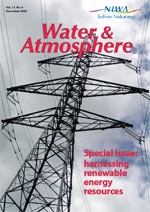

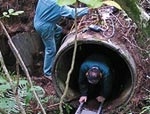

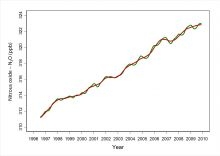
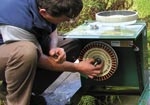
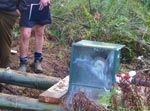
Installing the hydro generator at Waipoua. (Photos: Guy Penny and Neil Woodfield)
Guy Penny describes an innovative project to introduce small-scale energy technologies and enhance energy efficiency through retrofitting and education.
Taihoronukurangi e Taihoronukurangi e Tuia ai runga, tuia ai raro Ka pūwaha te tai nei, hoea tahi tātou Te Waka o Taihoronukurangi e
Rural Māori communities have specific issues in their access to energy and its use. The lack of local energy infrastructure has been identified as a constraint on Māori business development in many rural areas, and as contributing to the inefficient use of energy resources and general poor health of these communities. NIWA research is developing energy solutions in two rural communities with the aim of assisting others. This project is led by scientists in Te Kūwaha (NIWA’s Māori Research Unit) and involves a range of NIWA staff and the active involvement of two Māori communities, Waipoua in Northland and Waihi near Lake Taupo. Each community includes 15-20 homes, marae, wharepuni, wharekai, and a kōhanga reo, providing a cultural base for many hundred hapu members. The two communities offer contrasting situations: Waipoua is not connected to the national electricity grid and Waihi is.
Energy needs and household efficiency
In the first year of this four-year project, Te Kūwaha held several hui with each of the hapū to discuss the research concept, plan the various stages, and establish roles. This was followed by an energy audit, an assessment of community energy needs, and preparation for the deployment of equipment to monitor the renewable energy resources available in each community.
The energy efficiency audit involved walking through homes with the residents, looking for evidence of standard efficiency measures such as ceiling and under-floor insulation, thermostat settings and insulation on hot-water cylinders, lighting, appliances, heating, curtains, dampness, and mould. Because most homes were built before 1978, many were poorly insulated and damp, lacked insulation on hot-water cylinders, and didn't use energy-efficient lights or shower heads. We spent time with residents to understand their levels of comfort (or discomfort), and how they meet their energy needs.
At Waipoua we quantified annual fuel use (wood, petrol, diesel, and gas) and at Waihi we used electricity readings from the previous five years to determine average monthly household and community energy use for that period. Through a number of hui and the household energy audit, we developed a shared understanding of each community’s energy requirements and patterns of use. At Waipoua, for example, refrigeration, clothes-washing, safe lighting, and the capacity to power small household appliances (vacuum cleaners, stereos, handtools, and laptop computers) were identified as important energy-related problems. At Waihi, a large chiller and a hot-water cylinder for communal showers were identified as inefficient power uses, and several houses were in need of hot-water systems. Furthermore, both communities wanted to be as energy-independent as they could.
Local resources and retrofitting
In the second year, we implemented a specifically designed monitoring programme that would yield high-quality data on the energy resources (wind, solar, hydro, and wave) available at each site. After consultation, site appraisal, and resource-consent approval, community members helped erect masts with anemometers at 10-m and 30-m height and solar radiation sensors at both sites. A streamflow gauge was installed in the Waihi stream and we deployed a device to measure wave energy off the Waipoua coast. The Waipoua community recorded flow volumes of potentially useable tributaries to the Waipoua River. We also carried out a desktop assessment of local renewable resources based on existing information, including the geothermal resource at Waihi.
At this point, we began looking for suitable renewable technologies for each community and engaged Negawatt Resources Ltd and Ecoinnovation to assist with this aspect of the study.
It became obvious that retrofitting energy-efficiency measures would make a big difference to household comfort and reduce both electricity and wood consumption. Negawatt Resources Ltd helped organise the retrofitting, and we secured financial assistance from the Energy Efficiency and Conservation Authority (EECA) EnergyWise Home Fund. Both communities formed retrofit teams who were extensively trained by Grant Dunford of Negawatt. This provided income to the community and was an incredibly useful learning environment for residents to understand basic principles of heating, indoor air quality, and home energy management. Without this hands-on 'learning-by-doing' approach, many of the benefits of retrofitting are not realised because residents are not aware of how to optimise their system through simple behaviours. A feedback survey of both communities in September 2004 (5-6 months after installation and over the coldest July-August since 1986) indicated huge improvements in indoor air quality and comfort (warmer, drier, and fresher), firewood use reduced by a half to two-thirds, and some anecdotal evidence of improved health.
Renewable energy technologies
After reviewing the resource and energy-use data and what we'd learnt about the communities' behaviour, preferences, and capacities, we developed a proposal to trial a range of renewable energy options for each community. These options were discussed at hui and the following technologies were sourced and installed by NIWA, Ecoinnovation, and community members in mid-2005.
Waipoua (not connected to the grid)
At Waipoua, we installed a 350-W mini hydro system using Ecoinnovation’s ’smart drive' generator which produces 6-7 kWh per day. This requires a flow of only 2 litres per second and a 60-m head, and sources water from a tributary a kilometre away from the generation site. (Resource consent was required to take water from the stream.) The generator feeds three separate houses, powers two energy-efficient freezers, and excess power is used for a battery-charging station. Residents now have lighting and, with care, use TVs, radios, appliances, washing machines, and vacuum cleaners. We also installed a 720-W solar photovoltaic system with battery bank on the wharenui (1-5 kWh per day) which powers lights, appliances, and a 400-litre freezer. In addition, we installed six 120-W photovoltaic systems with batteries for individual households to use for lighting and appliances, and a 150-litre solar hot water (SHW) system for one household.
Waihi (grid-connected)
At Waihi, we installed a 720-W photovoltaic system on the wharekai (dining hall). This system does not have batteries, as excess power is fed to the grid through a specially designed inverter. This will help offset the chiller load earlier identified as a problem. We have also installed a 300-litre SHW system for the communal toilet block that will address the inefficient hot-water cylinder, and a 150-litre SHW was installed in a home that had no hot water. We are also investigating grid-connection issues and processes with the local lines and power company for a potential 150-kW mini hydro system.
Performance and suitability
We are monitoring and recording technical performance and community suitability of these trial systems. We also have the opportunity to trial a 300-W mini wind turbine for six months at Waipoua using the existing inverter; installation is scheduled for December 2005. The final part of the project will involve reporting our findings and improvements and providing feedback to the residents of Waipoua and Waihi as we prepare to leave both communities after our four-year partnership.
The power of change
- For many rural areas, increasing lines and electricity costs are making local, small-scale power generation an economic option.
- Retrofitting and education about energy efficiency can help improve comfort and health, and reduce energy costs.
- Small-scale energy technology can provide electricity for communities that are not connected to the national grid.
- For communities with suitable 'energy resources', grid-supply is an economic opportunity.
This research is funded by FRST. I acknowledge the support of NIWA staff Graeme Mackay, Steve Reid, Richard Gorman, Mike Carson, Barry Waugh, Rob Tasker, Taoho Patuawa, and Charlotte Severne. I also acknowledge the contribution of Michael Lawley of Ecoinnovation and Grant Dunford of Negawatt Resources Ltd to this mahi. Above all, I acknowledge the enthusiasm, support, and manaakitangi of the Waihi and Waipoua communities. Tēnā rawa atu koutou katoa.
No reira, e ngā karangatanga maha, nga hau e whā, tēnā koutou, tēnā koutou, tēnā koutou katoa.
Dr Guy Penny (Ngāti Kahungunu, Ngapuhi) is a geographer with an interest in sustainable communities and renewable energy. He is a member of Te Kūwaha and works with the climate and energy applications team at NIWA in Auckland and with other groups in NIWA.
Teachers’ resource for NCEA AS: Science 90191 (1.6), 90313 (2.2); Geography 90207 (1.6). See other curriculum connections at www.niwa.co.nz/pubs/wa/resources
